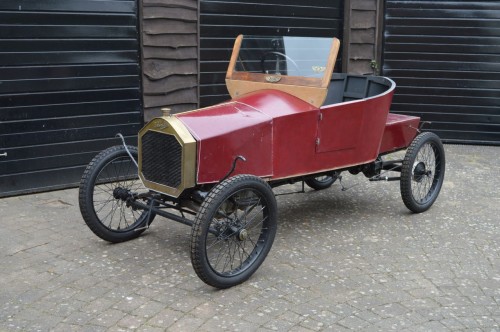
Click Here for Full Screen Image - Click Here to Download Image
 |  |  |  |  | |||||
 |  |  |  |  | |||||
 |
| Lot number | 150 |
|---|---|
| Hammer value | £6,500 |
| Description | Humberette V-Twin |
| Year | 1914 |
| Colour | Red |
| Engine size | 996 cc |
| Chassis No. | 7516 |
| Engine No. | H449 |
| Documents | New Zealand Reg docs; import paperwork; taxes paid |
Like so many other pioneers in the field of motor car manufacture, Humber started out making bicycles, graduating to four wheels as early as 1896.
They had considerable success with their 1903 De Dion-powered Humberette, a 613cc single with two-speed transmission which remained in production until 1905. A period of rapid expansion followed, with a wide range of Louis Coatalen-designed cars on offer, including an impressive six-cylinder model with a six-litre engine. A new factory was acquired in Coventry to meet demand which had outstripped the capacity of the original Beeston bicycle making plant.
This latter factory was then used to produce the ‘upmarket’ Humbers which were differentiated as Beeston Humbers, cars with better equipment and different radiators. The Coventry plant had been purpose-built to produce large numbers of vehicles and when a recession hit the market in 1908, Humber needed to reduce output and so decided its best option was to close the antiquated Beeston works entirely. During this period, Humber was ranked as Britain’s second largest manufacturer, just falling short of Wolseley’s production totals.
By 1913, Humber had decided to re-join the small car market, introducing the air-cooled twin-cylinder Humberette. Weighing in at less than 700lbs, it was taxed as a cyclecar, although was a far better product than most similarly classified machines, with its three-speed gearbox and shaft drive axle. At its peak, 70 Humberettes were leaving the Coventry factory each week, costing £125 each.
For an extra £10, the Humberette could be ordered with water-cooling, a feature found on this 1914 model which was exported to New Zealand, making its return in 1999 according to the import paperwork which confirms that all necessary duties have been paid.
Last registered for the road in 1963, the history file shows a photograph of the car in Christchurch a year earlier. It was imported by Dick Parrot and acquired by the vendor a few years ago through Jeremy Wade.
The vendor has fitted new tyres and tubes and confirms that the engine has two good compressions. The car has clearly had a great deal of work done to the chassis and bodywork in the past and looks to be a relatively straightforward project to complete. It even comes with its original stays for the cycle wings.
These Humberettes have a useful road performance thanks to their 998cc engine, low overall weight and quality construction, and as witnessed on the VSCC Light Car Weekend in Wales just a few weeks ago, can attack steep hills with aplomb. The vendor has reluctantly decided that he will never get round to completing this project and so has decided to pass it on to someone with a little more time on their hands.
Although the car has not yet been UK registered, it comes with New Zealand registration documents and import papers showing that all duties have been paid, so getting it registered here will be no more than a bureaucratic exercise.